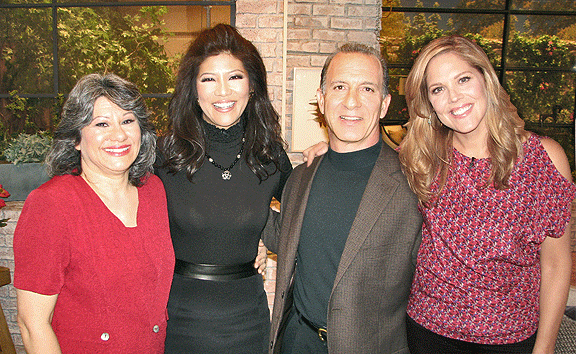This was a jam-packed appearance on The Talk. We were interviewed by Julie Chen and Guest Host Mary McCormick (The West Wing). We shared ideas from our book, The MoneySmart Family System, including:
Teaching kids to manage money with Toys, Clothes, Cars and College.
The tips spanned ages 3 to 23 and beyond.
We put together a list of tips from the segment with Steve Cunniff. Hope they help you raise MoneySmart Kids.
TALK TAKEAWAY: MONEY WITH STEVE AND ANNETTE ECONOMIDES
Recently, the USDA released a study that says the average kid costs $261,000 to raise — and that’s just to age 17! That’s just not a number that will work for most people. Steve and Annette Economides, also known as “America’s Cheapest Family,” spent an average of $61,000 on their five kids — that’s a 77% savings. For Annette and Steve, they aren’t raising children. They’re raising future adults that are fiscally responsible. Check out some of their tips below on how you can help your kids begin to manage their money.
TOYS
At five years old they can start earning and saving money. And you should start by getting them a three-part bank to teach them money priorities. That way they can decide how much of their money they save, how much they give to others, and how much they spend.
You should give your child opportunities to spend their own money on things that are affordable. Let them buy toys at garage sales or candy at the grocery check-out. And use wish lists — when they see something they really want, have them add it to a wish list instead of giving it to them. Wish lists teach your kids to delay gratification, to have patience, and to plan.
CLOTHES
Kids should start buying their own clothes, out of their household earnings, at age 11. And here are the ways you save money: you take them to shop at thrift and consignment stores, you go to garage sales, you utilize hand-me-downs, and you develop a network of parents who are in similar situations who can pass clothes on to your kids and vice versa.

We did get a few minutes after the show to talk with Julie and Mary, they were gracious and down to earth.

Producer Steve Cunniff is a genius, an excellent planner, and a great communicator!
CARS
Don’t buy a brand new sports car for your kids’ first car. As a matter of fact, don’t buy them a car at all. Help them plan and save, so they can purchase their own car with their own money. Stick with a more practical car, approximately ten-twelve years old. Let them drive the family car, insurance will be cheaper and it allows them time to save for a car purchase.
Things Kids should pay for:
- Insurance
- Gas (contribute some while driving your car)
- Car — with own money
COLLEGE
The average State University College cost (tuition, books, room & board) is $60,000. Steve and Annette’s son is on schedule to get a 4-year Business Management degree for a projected $7500 total (with 2 semesters left).
Here are tips that will bring your College costs down:
- Take AP classes in high school — it will lessen the credit load and cost at college.
- Do two years of community college to save money —start there, finish at a four-year school.
- Buy used text books – you can save hundreds per semester.
- Live at home.
- Apply for multiple scholarships.
- Minimize loans.
MoneySmart Families help kids graduate from college with a positive net worth.
“BOOMERANG KIDS”
60% of parents are assisting their financially dependent adult kids — 30% of young adults live with their parents. But adult kids at home (who are not attending college) can be an asset if you use the following tips:
- Kids should work full-time.
- Kids should pay rent — the deal can benefit both parties because the kids will pay less in rent than if they had their own apartment, and the parents will be getting some relief for their own finances.
- Use a contract — spell out exactly what is expected from both sides.
- Kids should help at home as parents get older and certain tasks become more difficult.

